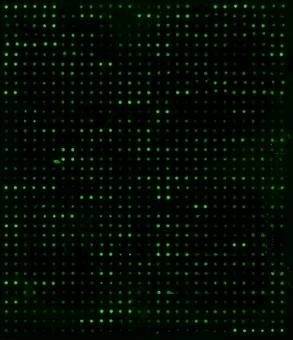Human L507 Array, Glass Slide
RayBio® L-Series Human Antibody Array 507 Glass Slide Kit. Detects 507 Human Proteins. Suitable for serum, plasma and cell culture supernatants.
Product Description
Specifications
| Size | 4 Sample Kit, 8 Sample Kit |
|---|---|
| Species | Human |
| Quantitative/Semi-Quantitative | Semi-Quantitative |
| Number of Targets Detected | 507 |
| Compatible Sample Types | Cell Culture Supernatants, Plasma, Serum, Tissue Lysates, Other Body Fluids, Cell Lysates |
| Solid Support | Glass Slide |
| Method Of Detection | Fluorescence Laser Scanner |
| Design Principle | Label-based |
| Estimated Lead Time | 1-2 business days |
| Shipping Type | Blue ice |
| Storage | -20°C |

Amazon Gift Cards!
$5 Amazon gift card in every kit box purchased.
Qu X., Zhou J., Wang T., et al. MiR-30a inhibits Th17 differentiation and demyelination of EAE mice by targeting the IL-21R. Brain Behav Immun. 2016 Oct;57:193-9. doi: 10.1016/j.bbi.2016.03.016.
Species:
Human
Sample Type:
Serum (MS versus Healthy Patients)
Guzzo, Christina, et al. "The CD8-derived chemokine XCL1/lymphotactin is a conformation-dependent, broad-spectrum inhibitor of HIV-1." PLoS pathogens 9.12 (2013): e1003852.
Species:
Human
Sample Type:
Conditioned Media (activated primary human CD8+ T cells)
Li Y, Flores R, Yu A, et al. ELEVATED EXPRESSION OF CXC CHEMOKINES IN PEDIATRIC OSTEOSARCOMA PATIENTS. Cancer. 2011;117(1):207-217. doi:10.1002/cncr.25563.
Species:
Human
Sample Type:
Plasma
Yousef H., Conboy M., Mamiya H., Zeiderman M., Schlesinger C., Schagger D., Conboy I. Mechanisms of action of hESC-secreted proteins that enhance human and mouse myogensis. Aging vol. 6 no 5.
Species:
Human
Sample Type:
Conditioned Media (Human Embryonic Stem Cell culture media)
Soria-Valles C., Osorio F., Gutierrez-Fernandez A., et al. NF-?B activation impairs somatic cell reprogramming in ageing. Nat Cell Biol. 2015 Aug;17(8):1004-13. doi: 10.1038/ncb3207
Species:
Human
Sample Type:
Conditioned Media (Néstor Guillermo progeria syndrome fibroblasts and mesenchymal stem cells)
Zhang Y., Liang X., Liao S., et al. Potent Paracrine Effects of human induced Pluripotent Stem Cell-derived Mesenchymal Stem Cells Attenuate Doxorubicin-induced Cardiomyopathy. Sci Rep. 2015 Jun 9;5:11235. doi: 10.1038/srep11235.
Species:
Human
Sample Type:
Conditioned Media (Bone marrow derived MSCs and induced cells treated with doxyrubicin)
Lee N., Park S., Kwon S., et al. Agouti Related Peptide Secreted Via Human Mesenchymal Stem Cells Upregulates Proteasome Activity in an Alzheimer's Disease Model. Sci Rep. 2017; 7: 39340. Jan 4. doi: 10.1038/srep39340
Species:
Human
Sample Type:
Conditioned Media (Co culture of SH-SY5Y and WJ-MSC cells (human neoblastoma with MSCs))
Versari, Silvia, et al. "The challenging environment on board the International Space Station affects endothelial cell function by triggering oxidative stress through thioredoxin interacting protein overexpression: the ESA-SPHINX experiment." The FASEB Journal 27.11 (2013): 4466-4475.
Species:
Human
Sample Type:
Conditioned Media (HUVEC in space)
Ryu B, Baek J, Kim H, Lee JH, Kim J, Jeong YH, Lee SG, Kang KR, Oh MS, Kim EY, Kim CY, Chung HM. Anti-Inflammatory Effects of M-MSCs in DNCB-Induced Atopic Dermatitis Mice. Biomedicines. 2020 Oct 21;8(10):439. doi: 10.3390/biomedicines8100439. PMID: 33096640; PMCID: PMC7589030.
Species:
Mouse
Sample Type:
Conditioned Media, Cell lysates (M-MSCs)
Straussman R., Morikawa T., et al. Tumourmicro-environment elicits innate resistance to RAF inhibitors through HGF secretion. Nature. 2012 Jul 26;487(7408):500-4. doi: 10.1038/nature11183.
Species:
Human
Sample Type:
Conditioned Media (Stromal Cell Lines)
-
Great productArray worked very well. I used the 4 sample set, followed the directions, and obtained very usable results. That said, the array is still finicky. The results obtained from each sample spot has a relatively large variation, and many of the spots have tails. However, the results don't seem to change, whether or not you include the tails in the quantification. The individual spots on the array could be controlled/printed better.
from University of California, Berkeley,
on
Write Your Own Review

